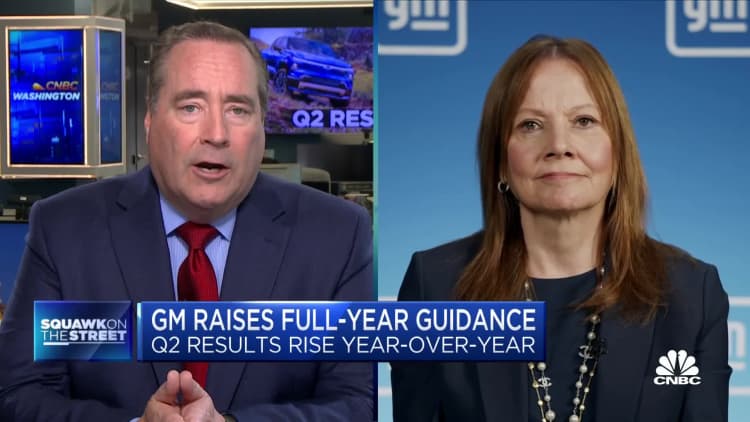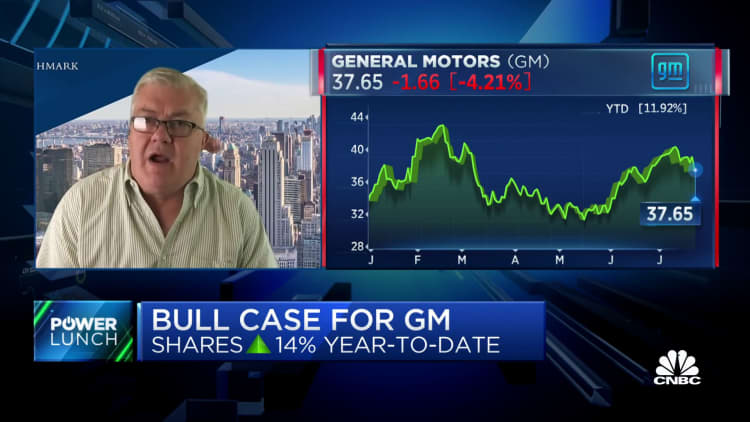A key test for EV sales and the adoption curve is coming
Electric Chevrolet Silverado shown at the New York Auto Show, April, 2022.
Scott Mlyn | CNBC
With unsold electric vehicles backing up on the lots of rivals’ dealers, General Motors’ electric-vehicle rollout strategy for the fall is shaping up to be a key moment for Detroit when it comes reading an uncertain EV adoption curve.
GM, so far, is acting as if it can withstand a current shakeout in the EV world, says analyst Brian Downey, executive editor of Autotrader, a division of auto-data company Cox Automotive. EV inventories were 92,000 as of June 26, up 350% from mid-2022, as models from automakers newer to the EV market like Kia, Porsche, Jaguar and Hyundai saw sales fall short of expectations and sales of Ford‘s Mustang Mach E dropped.
But GM reiterated in its earnings this week that it will double production of EVs in the second half of the year, to 100,000 units – including the long-awaited introduction of an electric Chevrolet Silverado pickup truck and EV versions of Chevy’s Equinox crossover and Blazer compact sport-utility vehicle. The company says it will reach 400,000 cumulative units of EV production by early 2024 and that its EV business will reach profitability by 2025.
“It’s the popcorn moment,” said Dan Ives, analyst at Wedbush Securities. “They have dozens of EV models over the next two to three years. These first models, coming from the 313 area code, will lay the groundwork. It’s really the next six to 12 months on which they’ll be judged.”
Investors liked much of this week’s news from GM, because the company raised its 2023 profit guidance for the second time this year, saying its automotive division’s free cash flow will be $7 billion to $9 billion, up from $5.5 billion to $7.5 billion. Morgan Stanley analyst Adam Jonas speculated that the company’s decision to trim capital spending, which accounted for most of the changed cash-flow forecast, might simply reflect conservatism heading into labor talks with the United Auto Workers union.
Shares dropped 4% after the company’s earnings beat Wall Street forecasts, and the stock finished the week down, though GM shareholders have still picked up a double-digit gain on paper year-to-date.
GM CEO Mary Barra told analysts on the earnings call that the reduction in capital spending was not related to a call on market demand. “There was no market-driven slowdown,” she said.
Wall Street analysts, though, remain unconvinced about near-term EV adoption rates.
“We would continue to advise investors to keep their expectations well managed with respect to the speed of the ramp and the ultimate size and profitability of GM’s electric vehicle business. We express this sentiment not just for GM, but for all legacy auto manufacturers,” wrote Morgan Stanley analyst Adam Jones in a note to clients after the GM earnings.
There is a core EV issue in the numbers: GM sold about 36,000 electric vehicles in the first half of 2023, according to Cox Automotive. With production set to zoom higher, the new models had better sell.

Among analysts who believe the stock is due for a bigger drop, expected EV sales disappointment is among the factors. Deutsche Bank analyst Colin Langan, whose $32 price target represents between a 15%-20% drop from this week’s GM share price, said in a note to investors that among the biggest risks to his sell rating is “the successful launch of key EV products such as the Cadillac Lyriq, GMC Hummer EV, Chevy Silverado / GMC Sierra EV, Chevy Equinox EV, and Chevy Blazer EV.”
CFRA Research analyst Garrett Nelson said in a note to clients after earnings this week, “We believe the near term earnings drag from GM’s EV transition will be significant, and have doubts about its production ramp-up and ultimate demand for its EV models amid growing signs of EV market oversaturation.”
Consumers may be more important to watch than investors right now. The models coming out this summer and fall include electric versions of GM’s top-selling vehicle, the Silverado, and its No. 3 model, the Equinox crossover (No. 2 is the GMC Sierra, which is basically another iteration of the Silverado). There will also be an EV version of the Chevy Blazer midsize SUV.
Preliminary pricing for the Equinox calls for it to start around $30,000 before a $7,500 federal tax credit. The Blazer’s final pricing will be announced by the first week of August, company spokesman Chad Lyons said, and its rollout will begin with its lower and middle-priced trim levels this summer. With gasoline engines, those Blazers start at a suggested retail price around $35,000 for the base level and $42,800 for the RS, well below the company’s second quarter average U.S. selling price of $52,248.
The Silverado, like many EVs, is an example of bringing more expensive models to market first, but GM expects to deliver more basic models next year, Lyons said. GM CEO Mary Barra told analysts after its earnings that she is “very confident with where we are in the pricing for the Silverado EV.”
The Cadillac Lyriq EV sedan, priced from $58,590 and competing with more expensive products from Jaguar and Audi, came out last year, Cadillac spokeswoman Katie Minter said. GM will also be rolling out the Cadillac Celestiq, a $300,000 model that will be custom designed for each customer.
The Cadillac all-electric 2023 Lyriq is displayed during a media day of the North American International Auto Show in Detroit, Michigan, September 14, 2022..
Rebecca Cook | Reuters
Paul Jacobson, GM’s chief financial officer, cited “pent up demand” for the new Lyriq in a call with analysts after earnings, and also cited the Chevy Bolt, which the company had planned to discontinue only a few months ago but has now decided to bring back. “We can’t build enough Bolts right now,” Jacobson said.
“People are hanging in there with orders,” Jacobson told analysts asking about EV pricing strategy. “I think with some of the challenges identified as we ramp production, we see a lot of consistent strong demand for the products that we’re producing.”
The moves will help cement GM’s place as the EV industry’s value choice as the business shakes out, according to Ives, who says he has driven all of the new models and is enthusiastic about the lineup’s ability to make GM relevant to younger demographics that look to imports first.
“This is not your grandfather’s GM,” he said. “Sweet design, massive tech upgrades, great battery life, no range anxieties. People will pull up to the valet parking in them. It’s not something you would consider before.”
According to Downey, the goal is to lure customers who have not been attracted to EVs for the sake of technology alone. As EV market leader Tesla has done by cutting prices this year, GM is moving to give EV options to the larger market of consumers who simply want trouble-free cars at attractive prices, he said.
‘Hard part’ of auto industry EV rollout is just beginning
As the industry wide EV rollout reaches a critical juncture, “GM is positioned well for the hard part,” Downey said. “Tesla people are not car buyers. They’re tech buyers. The next group of cars will meet people where they are. The next generation doesn’t care how cars are powered. They want them to be easy,” he said.
The need for more options in the EV market has been highlighted by inventory backups for many kinds of EVs during the second quarter, which largely spared GM, Downey said. (Tesla, which sells direct to consumers, is not included in Cox data tracing dealer inventories). Cox’s data shows a 21% year-to-date decline in unit sales through June, for example, for Ford’s Mach-E; and a growth stall for Hyundai’s Ioniq 5 crossover, as well as a slow start for its Ioniq 6 sedan. The Hyundais have been hurt by high prices and the fact that they are ineligible for federal tax credits because they aren’t made in the U.S., Downey said.
Barra expressed confidence across the EV portfolio. “We’re seeing with Lyriq, we’re seeing with the Hummer truck and SUV … the Bolt … these vehicles are getting to the dealers’ lots. And if they’re not already sold, they’ve got a list of people who are waiting for them,” she said. “For the rare customer who decides they’re not going to wait for the vehicle, there are several more waiting in line.”
Ford sent slightly different messaging to investors last week, saying that while it is losing billions to accelerate its EV manufacturing, it will also be ramping production of hybrids, including a hybrid F-150.
Downey says surveys show about half of car buyers would consider going electric. But the market so far is only about 6% electric, he said, as customers wait for the product they want, even as total EV sales rose 47% and brands like Volkswagen, Genesis, Rivian, BMW – and Chevy – all saw sales double.
“This will be the first year U.S. EV sales reach 1 million,” Downey said. “That’s a lot of ’em.”
For GM and Ford, the ultimate question is whether, when breaking apart that one million EV unit sales figure, they can sell all the electric cars and trucks they are currently gearing up to produce. For GM, the answer to that will come into focus beginning this fall.

For all the latest Automobiles News Click Here
For the latest news and updates, follow us on Google News.

